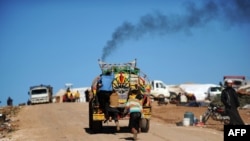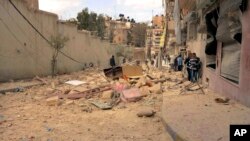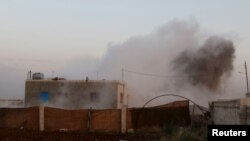Islamic State militants are maintaining their offensive on towns at the heart of a safe zone that U.S. and Turkish authorities want to carve out in northern Syria — despite Turkish fighter jets recently launching their first airstrikes as part of the American-led coalition against the jihadist terror army.
Rebel commanders say coalition strikes need to be ramped up to ward off the extremists.
The fight for the countryside to the north of Aleppo is now ratcheting up rapidly. Islamist rebel factions on Monday mounted several rocket barrages at IS positions in the villages of al-Madjanah and Tlalin. They managed to retake the town of Sadaf after heavy clashes with the extremists.
“Our fighters attacked IS headquarters in Sadaf town,” said Saleh al-Zeina rebel commander. “The militants were forced to evacuate the town. The town is now completely under our control.” How long that will be the case isn’t clear: the fighting in northern Syria has been marked in recent weeks by rapid changes in fortunes.
Islamic militants displayed the bodies of some of the fighters from moderate rebel and Islamist factions they had killed in a square in the city of al-Bab to the northeast of Aleppo. A commander with the Shamiya Front, coalition of hardline Islamist brigades as well as more moderate rebel factions favored by the West, says the Islamic State is still focused on trying to capture the key town of Marea, which they first tried in June.
In the past few days, the militants have launched as many as 50 suicide bombing missions on the town. There were three suicide bombings in Marea Monday, according to political activists.
Redoubled efforts
IS first launched a concerted effort to dominate the countryside to the north of Aleppo in early summer and came close to seizing the border town of Azaz in a bid to sever the rebels’ supply lines from Turkey. Only a desperate intervention by Islamist militias from a neighboring province prevented that from happening. The extremists’ redoubled their offensive since Washington and Ankara agreed to establish a safe zone in the Aleppo countryside — but disagreements between the two governments has delayed coalition action.
The fighting to the north of Aleppo illustrates how complex and tangled the Syrian civil war has become featuring a dizzying area of rebel factions, some approved of by the West while others are favored by Turkey and the Gulf countries, and two rival jihadist organizations — not to mention the Kurds and Syrian government forces. While coalition airstrikes are targeting IS extremists; regime warplanes have been pounding villages controlled by rebel factions and, according to insurgent commanders, chiefly those are that are important for their supply lines into Aleppo.
Syrian government forces have been mounting attacks on insurgent positions in the northern part of Aleppo city, according to a commanders with the rebel Military Operations Room in the beleaguered city, which is divided between the regime and rebels battling to oust President Bashar al-Assad.
Aleppo countryside
Marea is a key to much of the conflict in the northern Aleppo countryside — control of the town, which is only 35 kilometers from Aleppo and 10 kilometers from the main border crossing at Bab as-Salamah into Turkey, impacts crucial supply lines. Anyone who controls Marea is more easily able to strike at the Kurdish enclave of Afrin on the border.
Also over the weekend the Shamiya Front issued a statement declaring the whole of the border town of Azaz a military zone because of the precariousness of the military situation.
Rebel commanders say coalition airstrikes — despite the fact the U.S. has increased strikes in the Aleppo countryside — are not sufficient to drive IS forces out.
Some analysts agree with that view.
“While the coalition and Turkey squabbled among themselves, Marea was burning under the siege of the Islamic State,” according to Aymenn Jawad Al-Tamimi an analyst at the US-based think tank Middle East Forum.
U.S. and Turkish officials have acknowledged differences over the tactics to be followed in the carving out a northern safe zone. But they say the recent air raids featuring the first joint coalition airstrikes by Turkish warplanes is a sign of agreement now.
“Our fighter aircraft, along with coalition fighter jets, began carrying out joint air operations,” the Turkish foreign ministry announced on Saturday.
“Countering terrorist organizations is a national security issue of priority for Turkey. Our efforts to combat terrorism will continue resolutely,” the ministry added.
The air raids mounted by Turkish warplanes involved seven targets in Aleppo. The Turkish F-16 fighter jets that carried out the missions flew from the NATO’s İncirlik Air Base in southern Turkey. Turkey's state-run Anadolu news agency reported that coalition warplanes have also bombed the IS-held town of Manbij in Aleppo province.
In Washington, Pentagon Press Secretary Peter Cook said the Turkish airstrikes were "fully integrated" into the coalition campaign.










